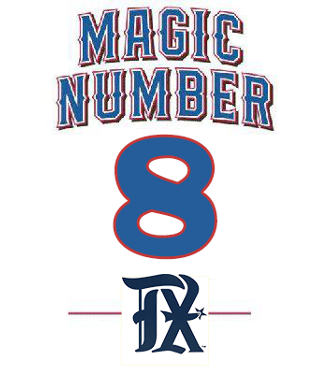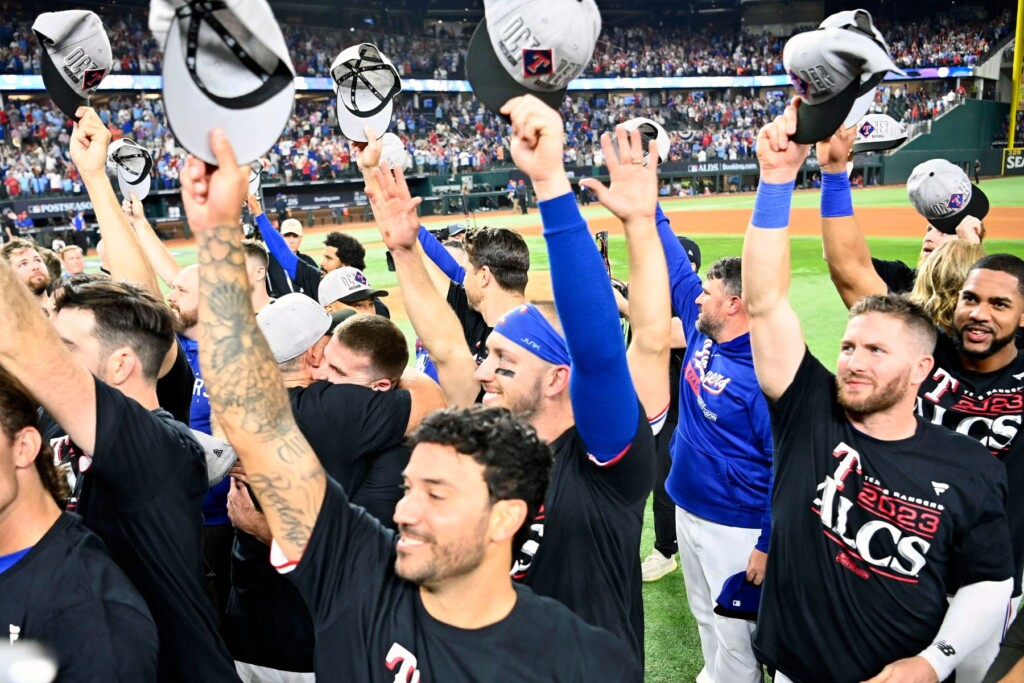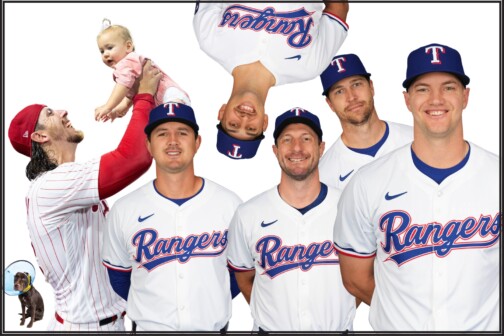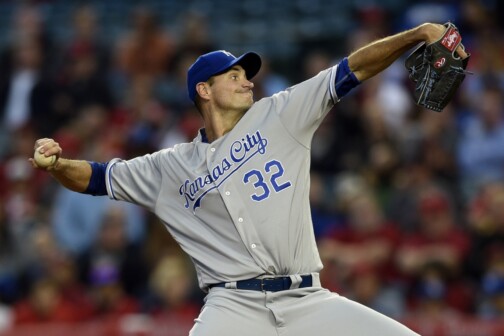Editor’s note: What’s old is new again. Mom jeans are fashionable. Same goes for loafers. You are, at most, three degrees of separation from someone with a variation of a mullet. And the Rangers are back playing October baseball.
So, back for the first time in seven years is Jamey’s Magic Number format. The premise is simple: for however many wins the Rangers have left to capture the World Series, Jamey will write that many items in this column. After Tuesday night’s 7-1 win over the Orioles, that number is now 8. If they take the opener of the ALCS in Houston or Minnesota on Sunday, it will be 7. And if the Rangers go all the way? Well, that’s the only time you should be excited about a Jamey Newberg column with zero to say (even though you’ll forgive him when he inevitably finds a thing or five to remark upon the World Series trophy finally coming to Arlington).
Let’s have some fun.

Here we go: 8 things.
8. It’s probably a little unfair that postseason performance will forever be a significant part of Clayton Kershaw’s career narrative. It’s 100 percent obligatory, on the other hand, to tie Nathan Eovaldi’s October reliability to his.
And yet, remarkably, at the end of Eovaldi’s seventh inning of work on Tuesday night, following an 11-pitch battle with Jordan Westburg that ended in the righty’s seventh strikeout (and sixth swinging), Eovaldi experienced a first.
The deafening E(o)-VAL-DI chorus, 40,000-strong, was organic and pure and awesome, evocative of the NAP-O-LI chants that were at their most thunderous on October 24, 2011, the night that Mike Napoli’s two-run, eighth-inning double broke a 2-2 tie in Game 5 of the World Series.
That night, 12 years ago, was also the last time the Rangers won a home playoff game.
For me, Cliff Lee will always be the paragon—and granted, this is just the ALDS—but Eovaldi is in the conversation.
Through two innings, the Rangers had scored six runs. Eovaldi didn’t throw his sixth ball until there were two outs in the third.
He didn’t issue a walk, and he didn’t go to three balls on a hitter until the seventh inning.
His 77.6 percent strike rate (76 strikes, 22 balls) was the highest in any MLB postseason start since Yankees lefty Andy Pettitte turned in an 80 percent performance in Game 2 of the 2001 World Series against the Diamondbacks. Pettitte lost that game, giving up four runs in seven innings. Eovaldi was never in any such danger.
Bruce Bochy talked after the game about Eovaldi’s “maniacal focus.” We could all see it. He kicked at the dirt when he missed his spot on a 1-2 pitch in the second inning.
Eovaldi in attack mode is pitching quintessence. He had all his pitches working—the splitter helps everything else play up—and never let the Orioles start to feel it. The man knows how to pitch with a lead. He carved all night.
The 33-year-old talked about a mechanical adjustment he made in a start in Seattle—correcting the rotation of his kick knee to gather more power (@PitchingNinja offers a great clip of the change)—a game the Rangers lost, 8-0, on the third-to-last day of the regular season, and said he has felt great since. The numbers bear it out: he has pitched two times since that game, allowing the Rays and Orioles one run each in a combined 13 2/3 innings, with 15 strikeouts and no walks. He’s the third pitcher in MLB postseason history with at least that many strikeouts without a walk in two starts, joining Lee (who did it with both Texas and Philadelphia) and Josh Beckett.
But the most indelible moment of Eovaldi’s postgame presser, for me, was when he was asked about the curtain call. Somehow, it was the first of his career from the home crowd. The one other came when he returned to Fenway Park this season as a Ranger—a nod to his postseason dominance with the Red Sox in 2018 and 2021.
His voice lowered as he reflected on the crowd’s thunderous chant of his name as he got bumps and hugs from teammates in the dugout, singling it out as “one of those moments you play for.”
It was “one of those moments” for everyone in the building, I imagine. I’m typing this sentence through chills.
What a game the crowd had.
7. “It was electric all night,” Eovaldi said. “The guys fed off it.”
Before the game, Leody Taveras beamed and said he couldn’t wait to experience a home playoff crowd.
Having been in Baltimore over the weekend, I was a little disappointed in the pregame energy in the ballpark. The seats filled slowly, and there was virtually no buzz as the crowd settled in, serenaded by stadium-ladled country music. Things picked up during player intros and when the crowd was prompted to wave towels for the national broadcast, before subsiding.
But then.
When Corey Seager turned around a down-and-in changeup, sending it 445 feet at 110 mph, a baseball whose destination he and right fielder Anthony Santander knew all about before Seager dropped his bat, the crowd exploded. And basically never stopped.
The “Party Time” video the Rangers played as the Orioles went to the bullpen in the second inning was goofy and cringey and awesome. It kept the high-voltage energy up even during a pitching change.
Look, if people are into folksy, twangy, plodding country music, it probably sounds great in the car on the drive up and the drive home. I am not even a little bit of a Creed fan, but I love that the Rangers players are—even if ironically—and the ballpark sing-along was money. Especially when the intermittent crowd shots included a cutaway to the Texas bullpen and the relief corps joining in the belting of the lyrics.
More of that, please. Whether it’s Creed or cat DJs or (Texan) Gary Clark Jr.’s banger rendition of “Come Together” or that ridiculous Poison song or some well-placed Led Zeppelin, more noise.
The best part is, aside from the pregame “wave your towels because we’re about to all be on TV solicitation, the reverberating crowd roar all night was instinctive and real and self-galvanized, not manufactured or begged. The A/V tapped into it, rather than needing to provoke it.
So good.
6. I don’t think I’d realized that when Seager went off in Globe Life Field in 2020, earning both NLCS and World Series MVP honors, that the Dodgers hadn’t won a title in 32 years. He talked about that pregame, saying Chris Young’s vision and plan appealed to his meticulous nature when he chose to sign with the Rangers—but that he was also intrigued by the idea of being part of a similar delivery in Texas, bringing a championship to a starved fan base.
If he’s able to enjoy that here, he’ll unquestionably be a massive reason why.
“What have you thought of your season to this point?” he was asked.
“I haven’t, to be honest,” he replied.
But the rest of us have, to be honest.
Just an extraordinary mix of sick talent and otherworldly focus. Seager doesn’t play with a ton of flash, but the vision of seeing him put his head down after connecting, knowing better than the rest of us that he could start a 360-foot trot before leaving the batter’s box, is about as adrenalizing as it gets.
An inning later, Mitch Garver once again made Baltimore pay for walking Seager ahead of him, and that’s a really massive development. Walks are fantastic—and are a huge reason Seager sits at .429/.680/.857 (1.537 OPS) this postseason—but the more pitches Seager gets to hit the rest of the way, the better the Rangers’ chances are to keep playing.
5. I feel like I’ve buried the lede, but that’s only because Game 3 had multiple ledes.
Seager getting the Rangers on the board and getting the crowd going was huge, but the at-bat of the game was an F-7 in the books.
Unless you keep a detailed book.
Texas sent six hitters to the plate in the first inning, leaving Nathaniel Lowe to lead off the second. In his final 60 plate appearances of the regular season, Lowe hit .094 and struck out 18 times. In the Rays series and the first two games of the Orioles series, he was 3 for 18 (.167) with seven strikeouts.
In his first trip on Tuesday night, he fell to .158 for the playoffs. And it may have been the most important at-bat of the night.
Lowe watched the first two fastballs from Orioles starter Dean Kremer, who needed 22 pitches to get through the first inning, and both found the zone. Then it was on. Kremer threw everything at Lowe. Four-seamers up, four-seamers down, cutters in. Lowe fouled off a pair of them and watched three others elude the zone. After that: seven straight foul balls before he lofted the 15th pitch of the at-bat fair, caught in left field for an out.
I’m not kidding about this: the crowd, by the last few pitches of the at-bat and even as Lowe returned to the dugout after the flyout, was virtually as loud as it had been on the Seager homer an inning earlier. Since MLB began tracking pitch counts in 1988, only a Johnny Damon at-bat in 2004 (16 pitches) and an Austin Meadows at-bat in 2021 (17 pitches) lasted longer in a playoff game.
Lowe forced Kremer to throw more pitches in that at-bat than Eovaldi had thrown in the first (11) or second (9) inning.
And it set the stage for the inning that changed the game irreversibly. Josh Jung lined a single to left on the first pitch after Lowe’s marathon. After Taveras popped out, Marcus Semien drilled a double to left center. Then came the intentional walk of Seager, Garver’s two-run double down the third-base line, and Adolis Garcia’s demonstrative, three-run blast.
Lowe set it all up.
And then, four innings later, Lowe destroyed a Kyle Gibson fastball on the inner half, a pitch whose outcome was as certain as the Seager home run. As much as I loved Garver’s mic drop on his grand slam in Game 2 and every Garcia bat flip, Lowe’s reaction to his shot, maybe 50 feet into the 437 it would travel, was the best home run reaction of the year. For all Lowe has gone through this year, at the plate and more importantly off the field, where his mother is battling brain cancer, he deserved that moment.
Even if his flyout to left was more important.
And I miss my dad.
4. Watch some video of Garcia’s home run—or his stack of line-drive singles up the middle in these first two playoff series—his head is not on a swivel. The swings are controlled, the balance is there, the 100-mph-plus outcomes are there.
He’s so good when he doesn’t sell out. He had plenty of moments in Tampa Bay and Baltimore over the last week when he ended up facing the third base dugout after a majestic swing that came up empty; it’s not as if he has eliminated that from his game. But he hits the ball extremely hard and often extremely far when he takes a more stable rip, and he’s much more challenging to pitch to when he’s willing to do that. After the game he said he has learned not to let his emotions get the best of him. When he’s swinging like that, some of that maturation shows.
It’s enough that he lets our emotions get the best of us.
3. All due respect to John Burkett, who recorded the only playoff win in the Rangers’ first 38 seasons, but Ian Kinsler, one of the best players in franchise history, not to mention manager of Team Israel in this year’s World Baseball Classic, should have thrown out the first pitch. He was in the building.
Burkett’s roll of the baseball to Mark McLemore was cute—Burkett and Mookie Betts are the game’s most prolific bowlers ever—but that one could have waited. The honor should have belonged to Kinsler.
2. As the Rangers limped to the finish of the regular season, there couldn’t have been a single thought that they’d be the first team to earn a spot in the postseason’s final four. But now they are there, having broken a five-game playoff losing streak at home with a win that gets them to the ALCS.
Beginning in May 2022, the Orioles had gone 91 straight series without being swept, the longest such streak since the Cardinals’ 79 years ago. The Rangers are the first team in MLB history to sweep two teams with a combined 200 regular-season wins out of the playoffs.
They outscored the Rays and Orioles, 32-12, a run differential that’s the second-highest for any team in MLB history in its first five games of a postseason. Throw out the eight runs allowed in Game 2 in Baltimore, and the total drops to an astonishing four runs in four games.
The pitching has been as dominant as the lineup.
1. And that’s without Max Scherzer. And without Jon Gray.
That could change in the ALCS, against Houston or Minnesota (a series I hope the Twins knot up tonight so that Justin Verlander and Pablo Lopez have to pitch on Friday). Scherzer and Gray are throwing sim games today, and depending how they come out of those and feel on Thursday, they may rejoin the staff for the ALCS, which could have a monumental impact not only on the rotation but the bullpen as well. Whether they are deployed in relief roles or as starters, having more than half of Scherzer, Gray, Andrew Heaney—who Bochy said would have started Game 4 if the Orioles had avoided elimination—Dane Dunning, and Martin Perez in the bullpen will make the staff so much deeper, if only on paper.
It’s amazing that two sim games are all that are being played at Globe Life Field today.
And that there will be at least two more games for a sold-out crowd here to do its thing.
Maybe more.
Author







